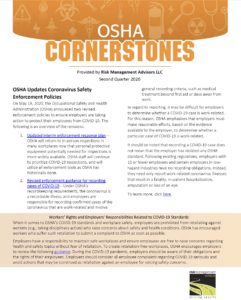On May 19, 2020, the Occupational Safety and Health Administration (OSHA) announced two revised enforcement policies to ensure employers are taking action to protect their employees from COVID-19.
The following is an overview of the revisions:
- Updated interim enforcement response plan— OSHA will return to in-person inspections in many workplaces now that personal protective equipment potentially needed for inspections is more widely available. OSHA staff will continue to prioritize COVID-19 inspections, and will utilize all enforcement tools as OSHA has historically done.
- Revised enforcement guidance for recording cases of COVID-19—Under OSHA’s recordkeeping requirements, the coronavirus is a recordable illness, and employers are responsible for recording confirmed cases of the coronavirus that are work-related and involve general recording criteria, such as medical treatment beyond first aid or days away from work.
In regard to reporting, it may be difficult for employers to determine whether a COVID-19 case is work-related. For this reason, OSHA emphasizes that employers must make reasonable efforts, based on the evidence available to the employer, to determine whether a particular case of COVID-19 is work-related.
It should be noted that recording a COVID-19 case does not mean that the employer has violated any OSHA standard. Following existing regulations, employers with 10 or fewer employees and certain employers in low hazard industries have no recording obligations. Instead, they need only report work-related coronavirus illnesses that result in a fatality, in-patient hospitalization, amputation or loss of an eye.
To learn more, click here.
Workers’ Rights and Employers’ Responsibilities Related to COVID-19 Standards
When it comes to OSHA’s COVID-19 standards and workplace safety, employers are prohibited from retaliating against workers (e.g., taking disciplinary action) who raise concerns about safety and health conditions. OSHA has encouraged workers who suffer such retaliation to submit a complaint to OSHA as soon as possible. Employers have a responsibility to maintain safe workplaces and ensure employees are free to raise concerns regarding health and safety topics without fear of retaliation. To create retaliation-free workplaces, OSHA encourages employers to review the following guidance. During the COVID-19 pandemic, employers should be aware of their obligations and the rights of their employees. Employers should consider all employee complaints regarding COVID-19 seriously and avoid actions that may be construed as retaliation against an employee for voicing safety concerns.
Preparing Workplaces for COVID-19
The COVID-19 outbreak has impacted businesses across a variety of industries, forcing them to rethink their daily operations to ensure the safety of their employees and the general public.
The COVID-19 outbreak has impacted businesses across a variety of industries, forcing them to rethink their daily operations to ensure the safety of their employees and the general public. This is particularly important as more businesses are allowed to reopen following mandated stay-at-home orders. In fact, just one misstep during this critical time can lead to the quick spread of COVID-19, jeopardizing the well-being of workers and customers alike.
To help slow the spread of COVID-19 and help employers safeguard their employees as they resume their operations, OSHA recently published its “Guidance on Preparing Workplaces for COVID-19.” The guidance includes a number of recommendations employers should consider to prevent the spread of COVID-19 in the workplace, which include:
- Developing an infectious disease preparedness and response plan—The guidance recommends that employers develop an infectious disease preparedness and response plan. Above all, this plan should take COVID-19 exposure scenarios, potential workplace controls and at-risk populations (e.g., workers with preexisting conditions) into account.
- Implementing basic infection prevention measures—The guidance recommends that employees emphasize basic infection prevention measures. This can include promoting personal hygiene, encouraging sick workers to stay home, implementing flexible work options, providing personal protective equipment and increasing routine workplace cleanings.
- Creating policies and procedures for identifying and isolating sick workers—Per OSHA, the prompt identification of potentially infectious individuals is a critical step in protecting employees and customers. Specifically, the guidance recommends that employers establish a means for isolating employees who become sick at work.
- Implementing workplace controls—The guidance recommends that employees implement a variety of engineering and administrative controls to control the spread of COVID-19. This can involve installing high-efficiency air filters, increasing ventilation rates, installing physical barriers, encouraging sick workers to stay at home, providing workers with appropriate training on COVID-19 and promoting personal hygiene.
It should be noted that COVID-19 policies and procedures will vary from workplace to workplace. Employers can review OSHA’s Guidance on Preparing Workplaces for COVID-19 here.




